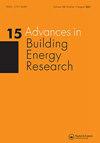Does detailed hygrothermal transport analysis in respiratory tract affect skin surface temperature distributions by thermoregulation model?
IF 2.5
Q2 CONSTRUCTION & BUILDING TECHNOLOGY
引用次数: 7
Abstract
ABSTRACT The prediction of the physiological response of the human body to the thermal environment is essential for healthy and comfortable indoor environmental design; hence, various rational thermoregulation models for estimating skin surface temperature have been developed based on the physics of heat and mass transfer between the human body and indoor environment, and on cybernetic models of the thermoregulatory system. Most of these models calculate the respiratory heat loss through the function of the pulmonary ventilation as well as the difference in water content between expiratory and inspiratory air, which describes a steady respiration process with a constant flow rate and fixed values of inspired/expired vapour pressure. In this study, a coupling numerical model combined with a thermoregulation model and a computer simulated person (CSP) with respiratory tract model that can be integrated with computational fluid dynamics has been developed. The coupling thermoregulation model used here are the multi-node model proposed by Stolwijk et al. and two-node model of Gagge, respectively. Based on this CSP with the thermoregulation model, a coupling analysis method combining the thermoregulation model and the model of dynamic heat and mass transfer/exchange in the respiratory tract is developed. This is followed by a discussion of the skin surface temperature predictions of the proposed model compared with those of the model using the traditional respiratory heat loss calculation method.通过体温调节模型分析呼吸道的详细湿热输送是否影响皮肤表面温度分布?
预测人体对热环境的生理反应对于健康舒适的室内环境设计至关重要;因此,基于人体与室内环境之间的传热传质物理以及温度调节系统的控制论模型,开发了各种合理的温度调节模型来估计皮肤表面温度。这些模型中的大多数通过肺通气的功能以及呼气和吸气空气之间的含水量差异来计算呼吸热损失,这描述了具有恒定流速和吸气/呼气蒸汽压固定值的稳定呼吸过程。在这项研究中,开发了一个结合体温调节模型和计算机模拟人(CSP)与呼吸道模型的耦合数值模型,该模型可以与计算流体动力学相结合。这里使用的耦合温度调节模型分别是Stolwijk等人提出的多节点模型和Gagge的两节点模型。基于该CSP和体温调节模型,提出了一种将体温调节模型与呼吸道动态传热传质模型相结合的耦合分析方法。随后,与使用传统呼吸热损失计算方法的模型相比,讨论了所提出的模型的皮肤表面温度预测。
本文章由计算机程序翻译,如有差异,请以英文原文为准。
求助全文
约1分钟内获得全文
求助全文
来源期刊

Advances in Building Energy Research
CONSTRUCTION & BUILDING TECHNOLOGY-
CiteScore
4.80
自引率
5.00%
发文量
11
 求助内容:
求助内容: 应助结果提醒方式:
应助结果提醒方式:


